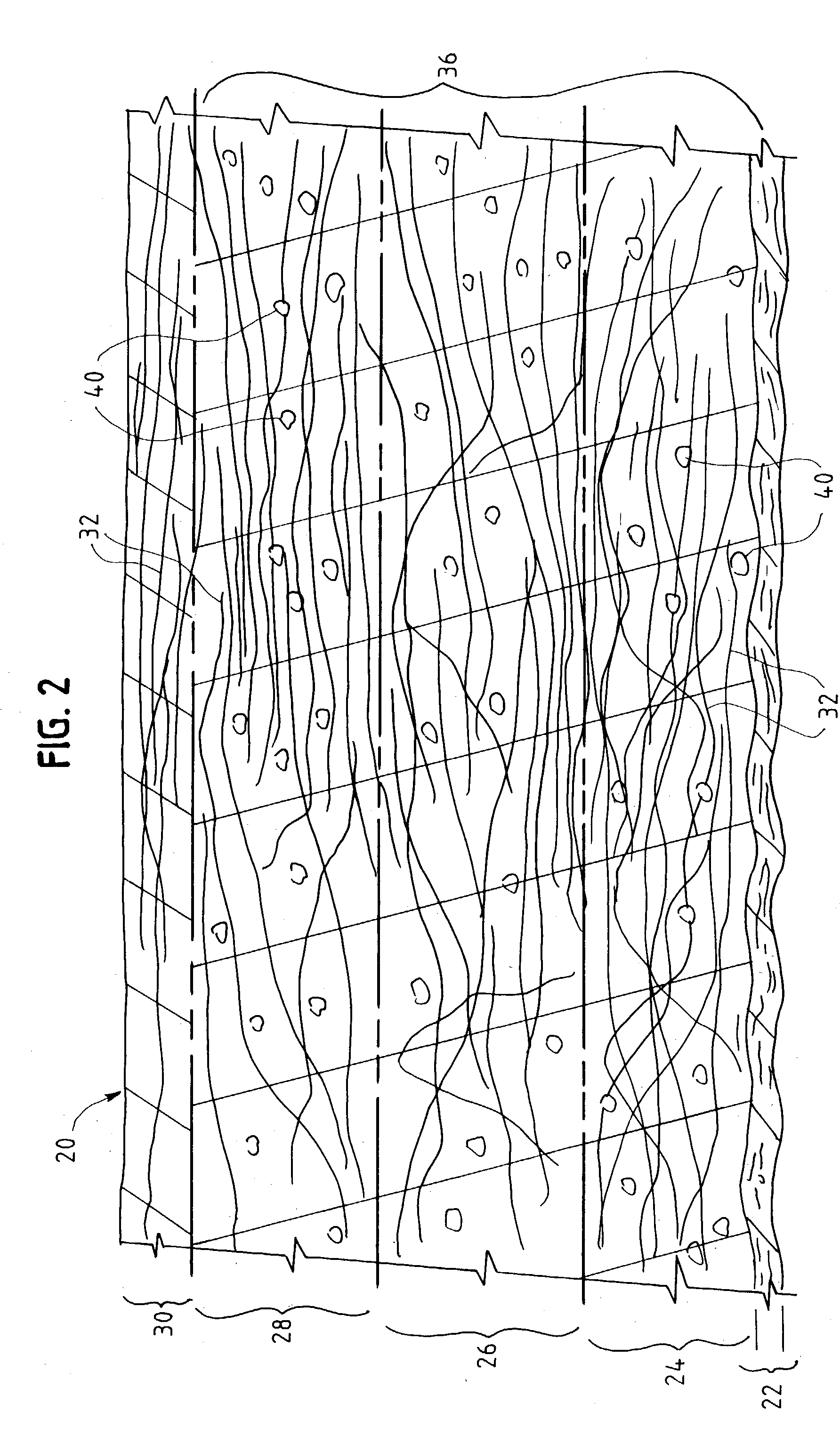Soft, absorbent material for use in absorbent articles and process for making the material
a technology of absorbent articles and absorbent materials, applied in the field of soft absorbent materials, can solve the problems of fine dust, high cost of wood pulp preparation, time-consuming and laborious wood pulp manufacturer's work, etc., and achieve the effect of reducing leakag
- Summary
- Abstract
- Description
- Claims
- Application Information
AI Technical Summary
Benefits of technology
Problems solved by technology
Method used
Image
Examples
example 1
[0209] Strength tests according to the above-described test were conducted on samples of absorbent material having the structure of the material 520 illustrated in FIG. 6. In example 1, the samples were taken from the material 520 as produced by the embodiment of the process illustrated in FIG. 7 except that the water spray addition via the nozzle apparatus 150 was not operated. Thus, no water was added to the material during processing.
[0210] The material 520 was produced with (1) an upper layer 529 having a basis weight of 42 gsm (grams per square meter) and 0% superabsorbent polymer ("SAP"), (2) a middle layer 526 having a basis weight of 89 gsm and 47.7% superabsorbent polymer by weight compared to the weight of the pulp fibers in the layer, and (3) a bottom layer 524 having a basis weight of 102 gsm and 45.7% superabsorbent polymer by weight compared to the weight of the pulp fibers in the bottom layer.
[0211] In each sample, the top layer 529 and middle layer 526 contained pulp...
example 2
[0221] The effect of moisture (e.g., water) addition to the tissue during the process of making the absorbent material was investigated. In Example 2, the embodiment of the process illustrated in FIG. 7 was operated as in Example 1 described above, but with water sprayed against the tissue layer web for runs using three different tissues, and without water sprayed against the tissue for two other "control runs." Table 2 lists characteristics of the material produced in each run in Example 2.
[0222] The upper layer 529, middle layer 526, and bottom layer 524 of the absorbent core portion 536 for the Example 2 runs had the same pulp and superabsorbent composition as in Example 1. The processing line (FIG. 7) was run at the same speed and same calender roll temperature and compression force as in Example 1. For Sample Runs 1, 3, and 4 in Table 2, water was sprayed from the above-described nozzles of the device 150 (FIG. 7) against the bottom of the tissue layer web 62 from a distance 10...
example 3
[0231] Example 3 investigated the effect of spraying water onto tissue on a laboratory scale. Absorbent material having the structure illustrated in FIG. 6 was used, but the composition of the absorbent material differed from that described above in Example 1 and in Example 2. Specifically, the material 520 (FIG. 6) used in Example 3 was produced with an upper layer 529 having a basis weight of 25 gsm and 0% superabsorbent polymer, a middle layer 526 having a basis weight of 225 gsm and 57% superabsorbent polymer by weight compared to the weight of the pulp fibers in the layer, and a bottom layer 524 having a basis weight of 233 gsm and 54% superabsorbent polymer by weight compared to the weight of the pulp fibers in the bottom layer. In each sample, the top layer 529 and the middle layer 526 contained pulp which was 100% southern pine Kraft processed pulp. The bottom layer 524 included southern pine pulp in a blend of 78% by weight of Kraft processed pulp and 22% by weight of cold ...
PUM
| Property | Measurement | Unit |
|---|---|---|
| temperature | aaaaa | aaaaa |
| temperature | aaaaa | aaaaa |
| surface temperature | aaaaa | aaaaa |
Abstract
Description
Claims
Application Information
 Login to View More
Login to View More - R&D
- Intellectual Property
- Life Sciences
- Materials
- Tech Scout
- Unparalleled Data Quality
- Higher Quality Content
- 60% Fewer Hallucinations
Browse by: Latest US Patents, China's latest patents, Technical Efficacy Thesaurus, Application Domain, Technology Topic, Popular Technical Reports.
© 2025 PatSnap. All rights reserved.Legal|Privacy policy|Modern Slavery Act Transparency Statement|Sitemap|About US| Contact US: help@patsnap.com



